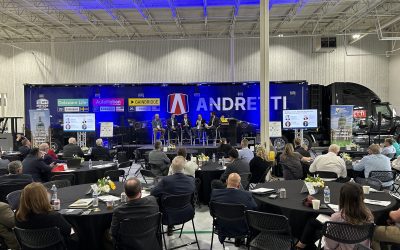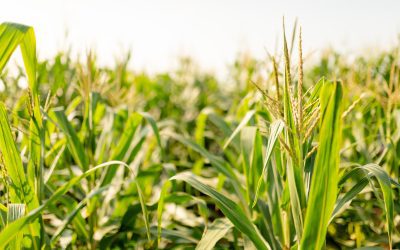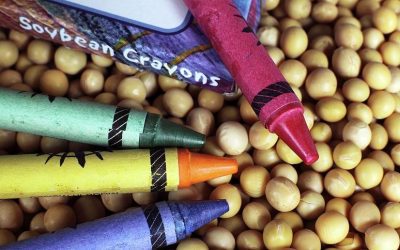A desire to promote U.S. farm products has taken Beard around the world
Posted: November 2, 2022
Category:
ICMC, Indiana Corn and Soybean Post - Fall 2022, ISA, News
Mike Beard has always had an interest in foreign trade policy and how it can help farmers. That interest has led to Beard’s second passport getting stamped by countries from all over the world.
“As a member of the United Soybean Board (USB), we couldn’t address policy issues. But as a checkoff organization, we could fund efforts to promote exports,” he said. “While with USB, I began traveling to countries to promote trade and soybeans. That’s when I became associated with the U.S. Soybean Export Council (USSEC). I’ve been to a good many places promoting soybeans for foreign trade.”

Beard, who graduated from Purdue University with a degree in agricultural economics, went straight into the industry selling a new herbicide called atrazine, which was introduced to the marketplace by Geigy Chemical Company. He purchased his first farm in 1972 and started farming fulltime in 1975.
When Beard’s wife, Pam, passed away a couple years ago, a succession plan for the farm was triggered.
Beard’s son, David, manages the family farm today, which consists of corn and soybeans, as well as the contract growing of about 35,000 hogs per year, and a small business of custom application of hog manure. One of his grandsons, Elijah, who recently graduated from Purdue, assists in managing the farm. Beard’s daughter, Jennifer, manages the operation’s books and financial details.

Beard is a former president of the Indiana Corn Growers Association (ICGA) and Indiana Corn Marketing Council (ICMC) and has been president of the policy committees for the Indiana Soybean Alliance (ISA) and the Indiana Pork Producers Association. But his support and expertise does not end with this state. Beard has also served in trade and policy-related positions on the USA Poultry and Egg Export Council (USAPEEC), USB, the National Corn Growers Association (NCGA) and the U.S. Meat Export Federation (USMEF).
Today, Beard is enjoying the twilight of his duties as he is finishing the last years of his nine-year terms.
“It is important to understand that when you have a role in these organizations, you are there to review the projects that farmers’ monies fund, and to make sure the programs bring value to that investment,” Beard said. “Because that is an investment made with our corn farmers’ membership and checkoff dollars, so you have a responsibility to the members.”
Boots on the ground
USAPEEC, USMEF and other organizations Beard has served in have boots on the ground in several foreign countries that facilitate visits to build relationships and to make sure the farmers’ investments are being used wisely. As far as Beard is concerned, even in this digital age, nothing is more impactful in visiting importers than building relationships.
“It may not be the only factor, but I think it is very important,” Beard said. “One of the ways I think I measure the success of trade visits is seeing how long those relationships last.” Beard added he has often found proof that these connections are in place.
“We visited the Japanese executives of the Indiana Packing Company during a trip to Delphi (Ind.) when I was with the Indiana Pork Producers Association,” Beard recalled. “Years later I was on a trade mission with Gov. Daniels, attending a reception in Japan, and next to me in line was a man named Watanabe. He remembered me from that visit, and so, Watanabe was my host and escort for the rest of the day.”

Visits to importers in other countries, as well as hosting similar groups in Indiana, is crucial to fostering better relationships. In this way, producers also get some idea of what the marketplace demands.
As Beard mused, “If an importer wants a chicken with four paws, maybe we need to address that opportunity.”
Another time, Beard was on a USSEC mission to China and at a large reception, he was recognized by an executive with China’s Chamber of Commerce. Beard had hosted the executive during a visit to his farm.
“At this reception, we were all seated at a very long table, and it was hard to see who was up front, but as we went around the table, I introduced myself,” he said. “The man who was the chair of the meeting was an executive for China’s Chamber of Commerce. When I introduced myself, he said, ‘I’ve been on his farm!’ So, you’re on the other side of the world, and there are people there who remember being on your farm. I still think relationships are very important when making a decision – deciding whether they are going to buy from the U.S. or from Brazil, for example.”
Beard said trade missions allow for the opportunity to settle questions or concerns importers may have with the quality of their imports. Corn and soy can be categorized by their quality. In Indiana, most farmers pull the highest quality of corn and soybeans out of their fields. But exported crops can also be sold cheaper in a lower quality category. That product still contains all the nutrition buyers ask for, but there is a preference for higher quality.
“I’ve been on missions where we’ve had significant questions on the quality of product of corn and soy that we were shipping or exporting to them,” Beard said. “We had the opportunity to explain what we produce in quality at the farm level. In some cases, we were finding that they were not buying No. 1 corn in quality, they were buying No. 4, and they were getting what they were paying for. We are able to explain, that by paying a little bit more, they can get a lot higher quality of product.”

There have also been cases, Beard said, where sellers havetaken advantage of the importer. Trade organizations can investigate that and find the proper avenue to correct the situation.
“We take a lot of pride in what we do produce, because it’s a top-notch product,” he said. “If they have questions or concerns, we get someone to work with them who knows what they’re doing to sort out any potential problems.”
Benefits of U.S. grains and meats
Talking to potential importers gives Beard the chance to point out benefits of U.S. grains and meats.
“There is a level of protein, but there’s also a quality of protein,” Beard said. “U.S. quality of protein is higher than any other. We also talk about our delivery system in the U.S. We have quality grain storage and logistic systems which are capable of shipping large amounts of grain via our water transportation system in a very timely manner.
“In general, the U.S., and Indiana especially, uses less tilling and chemicals. We generally have smaller impact on the environment than other countries they may import corn from.”
Any corn or soybean farmer with access to the internet can find out how important exports are to their bottom line. Just visit our website or those of the national organizations to learn of the return on investment trade promotion investments generate. Beard said it’s probably not at the top of most farmers’ minds, yet we still have strong support by the checkoff programs in Indiana. This tells Beard that Hoosier farmers support the programs they fund.

“They may not know exactly what it is we do with their funding, but they are responsible for putting me and other members of the boards and councils in the position to make those decisions,” he said.
Soybean farmers depend on exports, he added. Exports comprise nearly 40 percent of U.S. soybean market. U.S. corn is not quite as dependent.
Beard speculates that farmers may have to replace some of their domestic ethanol demand. Exports are a major target for moving corn that would normally have gone into ethanol.
“Any new market helps our bottom line,” Beard said. “We don’t see many new markets here at home for corn, so increasing corn grain exports or more especially a foreign ethanol market would be terrific. We need to encourage our legislators to enable trade negotiations with other countries – having lost the opportunity of the Trans-Pacific Partnership (TPP) that former President Trump dumped, which would have included 12 countries.”
Beard said not pursuing bilateral trade agreements affects the ability of U.S. commodities to compete in exports, no matter how many trade missions are made. He said if those countries are not friendly to importing from the United States, then it will not happen. When Beard worked with USAPEEC, tariffs on poultry had been so heavy there was no market in China. Through COVID and other situations, tariffs have modestly dropped, and a Chinese poultry export market has been pieced together.
“But it is still subject to tariffs and a rather fragile market overall,” Beard said. “Because you never know from month to month what may become of that market, or if it will exist at all.”
As Beard puts it, there are at least two legs to this stool, and one of them is government trade policy. He said producers should be encouraging legislators and administrators to promote foreign trade.
“I think when the Indiana corn or soybean grower takes time to think about their markets, they come to the conclusion that exports are important,” he said. “But we tend to focus only on raising the product.”
Once it’s out the gate, growers tend not to think about where that product goes, Beard said. But someone does need to think about it, which is why he and commodity organizations travel the world promoting U.S. agricultural exports.



